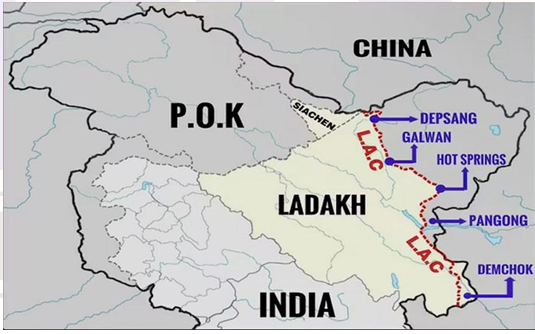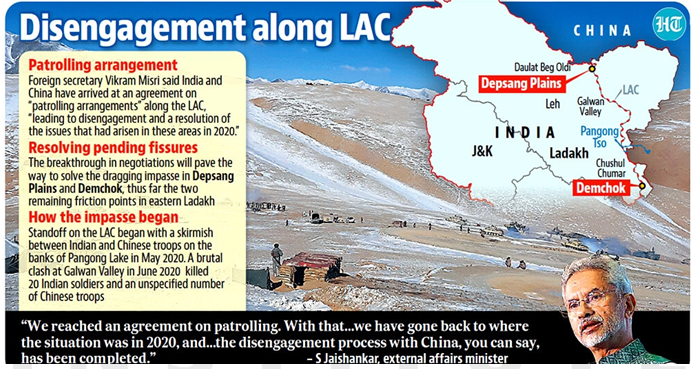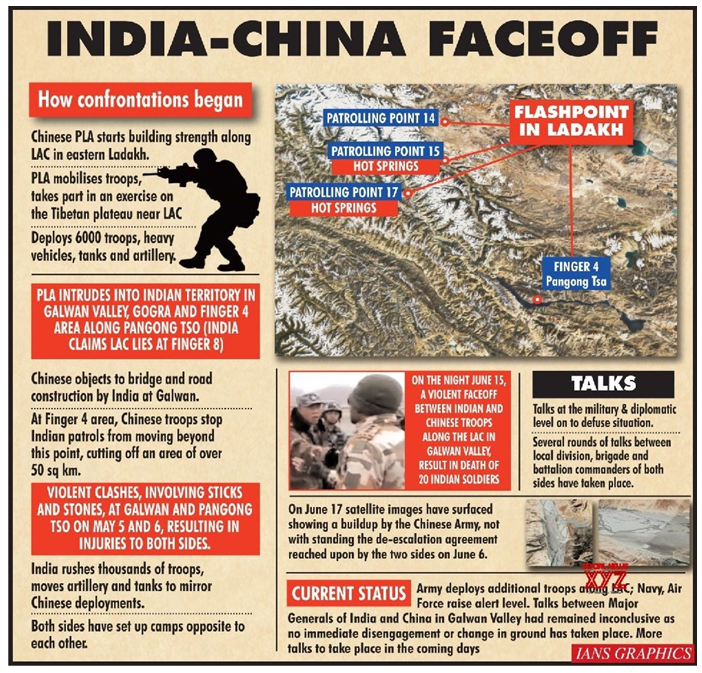
INTRODUCTION:
- In a significant breakthrough four years after the Galwan Valley clash, India and China have reached a patrolling arrangement along the Line of Actual Control.
- Indian and Chinese soldiers would now be able to patrol the border area in the way they did before the May 2020 face-off.
INDIA-CHINA BORDER DISPUTE
- Historical Background: The border dispute stems from colonial-era agreements, particularly the McMahon Line, which China does not recognize.
- Regions Involved: Key disputed areas include Aksai Chin (claimed by India, controlled by China) and Arunachal Pradesh (claimed by China, administered by India).
- India-China War, 1962: The 1962 Sino-Indian War was a significant conflict, resulting in a Chinese victory and the establishment of control over Aksai Chin.
- Line of Actual Control (LAC): The LAC is the de facto border post 1962 India-China War , but its exact alignment is not clearly defined, leading to frequent skirmishes.
- Military Presence: Both nations have increased military deployments along the LAC, conducting infrastructure development and troop mobilization.
- Diplomatic Efforts: Various rounds of talks have occurred to resolve the dispute, but progress has been slow and often stalled.

FRICTION POINTS ALONG LINE OF ACTUAL CONTROL (LAC)
These are all disputed areas where Indian and Chinese soldiers fought in the 1962 war.
- Galwan: On June 15, 2020, Indian and Chinese troops clashed in the Galwan Valley along the Line of Actual Control. Border infrastructure developments and differing perceptions of the LAC had triggered the clash. Following the clash, both sides engaged in de-escalation talks amid heightened tensions in bilateral ties.
- Demchok: Demchok is split by the LAC. India controls the western part. The eastern side is under the control of China, which also claims the western part. The dispute hinges on historical treaties and the precise alignment of the LAC along the Charding Nullah. Recent talks aim at disengagement.
- Pangong: About 50 per cent of Pangong Lake area is in Tibet (under Chinese control), 40 per cent in Ladakh and 10 per cent is disputed. Discrepancies in LAC perceptions lead to military standoffs and buffer zones, with ongoing construction and strategic positioning reflecting the tensions and claims by both nations.
- Hot Springs: Located near Gogra Post, the Hot Springs area is significant for India due to its strategic location which facilitates surveillance over LAC. India’s control over this region enhances its defence posture, providing vantage points for monitoring movements in Aksai Chin, thus playing a crucial role in border security dynamics.
- Depsang: Depsang plains are critical for India due to their strategic access to the Daulat Beg Oldie (DBO) airstrip and the Darbuk-Shyok-DBO road. Control over Depsang prevents Chinese forces from threatening these vital logistics lines, making it essential for India’s northern border defence and military mobility.

KEY OUTCOMES
- Patrolling Restoration: Both sides will resume patrolling in previously restricted areas like the Depsang Plains and Demchok, following pre-2020 patrolling norms.
- Peace and Tranquility: Aimed at restoring stability along the LAC, monthly meetings between commanders will maintain communication to avoid clashes.
- Troop Reduction: While there’s no immediate troop withdrawal, both sides will gradually reduce forces, especially in line with India’s winter strategy for Ladakh.
- Patrolling Coordination: Patrolling will be twice a month, with coordinated schedules to prevent face-offs.
- Strategic Importance: Key areas like Depsang Plains and Demchok, critical for India’s border security, will see renewed access.

SIGNIFICANCE
- Buffer zone: Soldiers from both sides, as a result of a grievance, agreed to go back a certain number of kilometers, and the areas that fell in between, which included points that were disputed would be where troops from neither side would go. Structures that were built in these locations during the stand-off by either side were also removed as the disengagement talks progressed over the months and years.
- De-escalation: The agreement signals a move towards de-escalation in a region where both countries have stationed tens of thousands of troops. Reversion to the patrolling norms of 2020 reduces the chances of skirmishes or escalation due to close military encounters.
- Stabilisation: This agreement helps stabilise the situation along the LAC by potentially reducing confrontations at friction points such as Depsang Plains and Demchok. Stability along LAC could foster a better environment for broader negotiations on boundary issues.
- Confidence-building: The resumption of patrolling as per pre-2020 terms is a confidence-building measure. It indicates a mutual willingness on both sides to return to a status quo that they found acceptable before the recent tensions. This also paves the way for further dialogue.
- Political Implications: The agreement might facilitate higher-level diplomatic interactions, like possible meetings between leaders at international forums, and enhance bilateral relations outside military confrontations. For India, this could mean better management of its border infrastructure development without an immediate threat of conflict. As for China, it may reflect a strategic choice to stabilise its border with India amid other global tensions.
This agreement signals a move toward de-escalation and stabilization, though full troop withdrawal is yet to be achieved.
CONCLUSION:
The India-China dispute is influenced by broader regional dynamics, including alliances, trade relations, and strategic interests in South Asia. A successful patrolling agreement could pave the way for further negotiations on more comprehensive border resolutions. The agreement reflects larger geopolitical trends, including the need for dialogue amidst rising nationalism and security concerns in both countries.
SOURCES:
